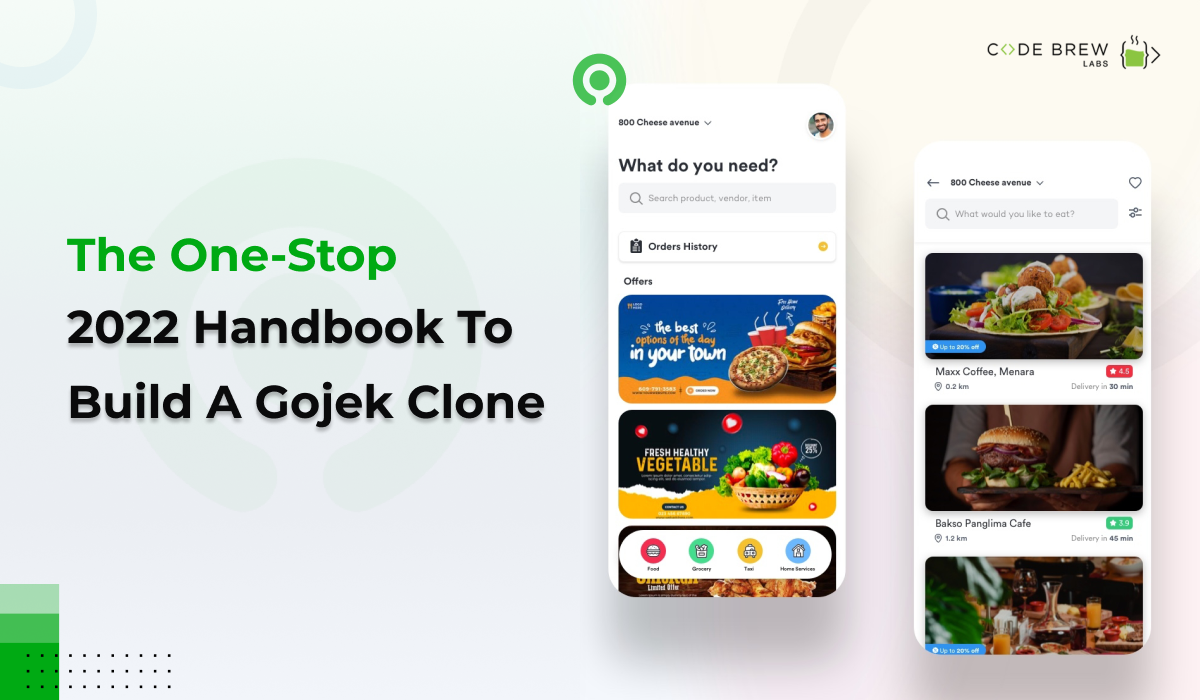
Gojek had only 20 motorcycle drivers providing on-demand bike rides to passengers when its journey started in 2010.
Table of Contents
Soon, the Indonesian company stood out from its competitors by using scooters and motorcycles instead of cars to avoid huge traffic jams. With this brilliant idea, the Gojek app’s services became wide-ranging & hassle-free.
Later, the company also started providing food delivery and courier services. In 2015, Gojek launched its official app with four services: GoRide, GoSend, GoShop, and GoFood.
Today, Gojek provides 20+ services that users can access from just a single app. Simply put, Gojek changed its business model to a super app; the rest is history.
Gojek Indonesia–is the one-stop destination for paying bills, ordering food, booking movie tickets, sending/ receiving packages, buying groceries, booking two-wheeler or four-wheeler taxis, paying money digitally, and much more!
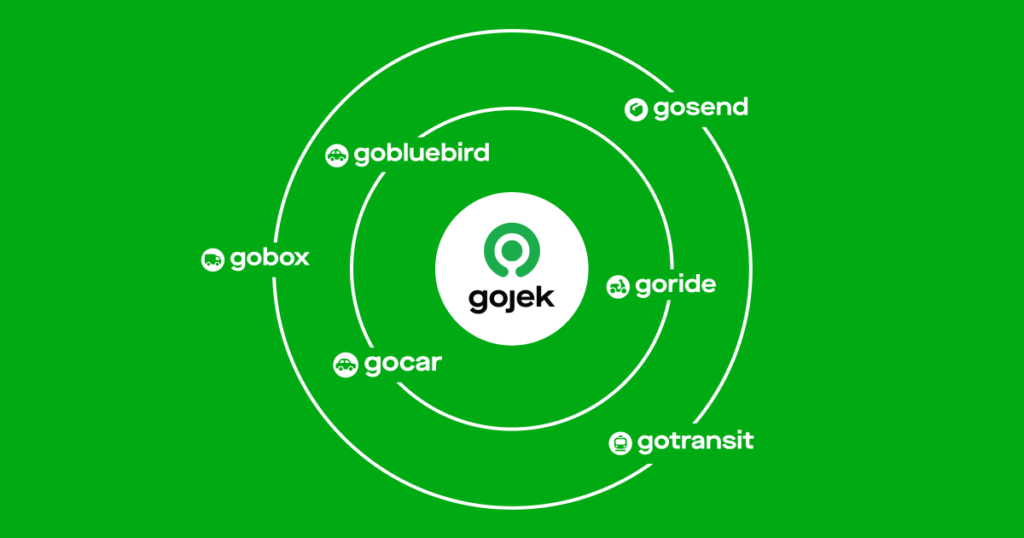
Source: Sketchnote
If you have a multi-service business and want to scale growth, we highly recommend you build and launch a Gojek clone. As you know from all that you read above, it is a tried and tested solution that will deliver consistently exponential returns for your business.
And for that, hiring expert developers for Gojek clone app development will help you go a long way as an entrepreneur.
Gojek was founded by Nadiem Makarim in 2010. Initially, the on-demand services startup did not receive a lot of traction. However, the tide soon turned in favor of the stakeholders in January 2015 when the Gojek app was launched.
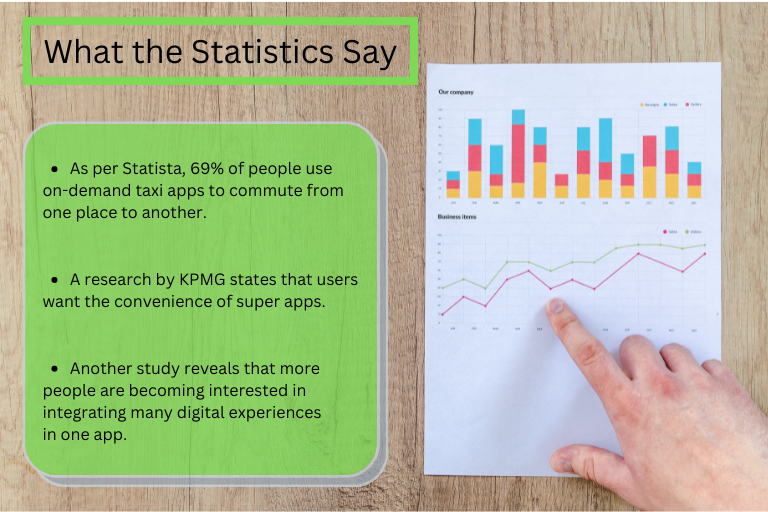
The company’s digital product play was about bringing together a bunch of different services on top of a last-mile delivery network.
Gojek follows the super app business model where users are offered a wide range of services on a single platform. So, instead of using one app to book movie tickets & another one to send packages, a user can use Gojek to fulfill both these demands.
The super app model provides a more convenient approach while saving consumers’ time. Such a business model delivers great results because consumers’ patience level has drastically decreased. As a result, customers seek to get things done at the earliest.
The business model of Gojek or a Gojek clone comprises three segments: consumers, merchants, and drivers.
The consumer identifies the kind of service(s) they want. These services could be booking movie tickets, a two-wheeler ride, sending packages, or ordering food.
Consider that the customer wants to order food online. Then, Gofood is the right option. The next step would be to select their desired food and add it to the cart.
Finally, the customer has to pay the money. After this, they will receive the food at their doorstep.
The merchant receives the order details in the Gojek app once the customer orders the food in the app or requests any other service.
After going through the order details, the merchant starts processing the order.
While the delivery partner gets on their way to pick up the product, merchants ensure that they make the product available for dispatch.
When the order is ready, the delivery person takes the product and delivers it to the customer’s doorstep. Upon handing over the product by the delivery person, the money is instantly deducted from the merchant’s GoPay wallet.
Note that transactions on Gojek are majorly done via GoPay.
They need to first sign-up with Gojek by providing some basic details like name, identity proof, address, vehicle number, and license number.
Drivers can choose from a wide range of services. They can sign up as a two-wheeler taxi driver, a car driver, a delivery person, etcetera. To get started, they need to turn on the online icon in the Gojek app.
Once the app is turned on, the drivers start receiving orders. And, if a delivery person is busy delivering products, the app shows him as ‘busy’. Then, the order is automatically assigned to another driver.
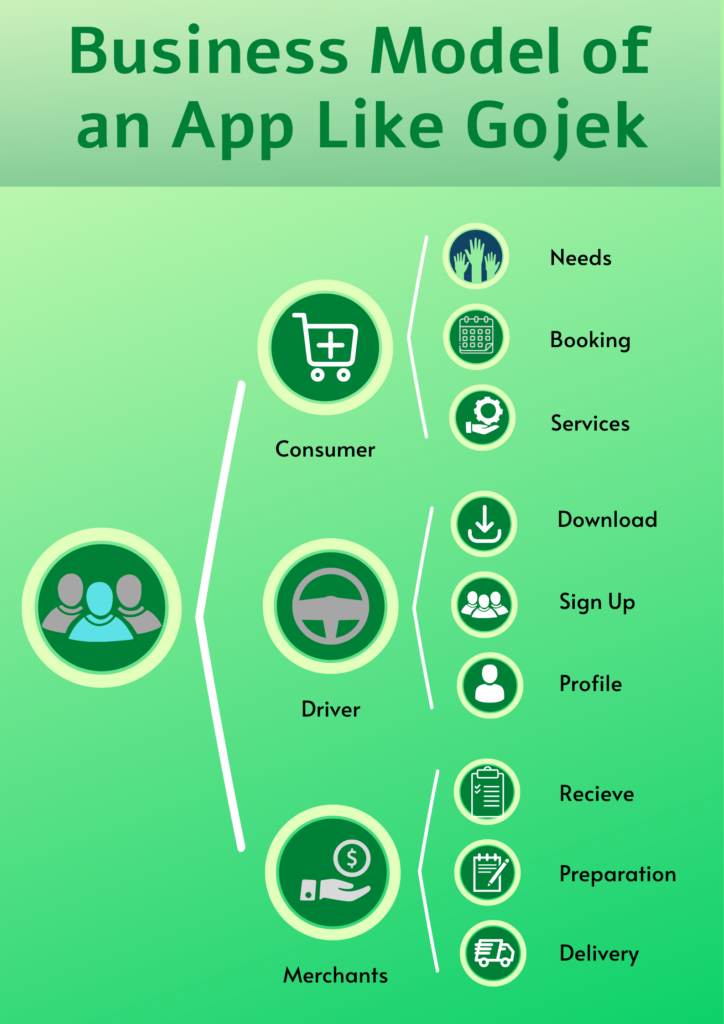
The business model of Gojek or a Gojek clone comprises three segments: consumers, merchants, and drivers.
The consumer identifies the kind of service(s) they want. These services could be booking movie tickets, a two-wheeler ride, sending packages, or ordering food.
Consider that the customer wants to order food online. Then, Gofood is the right option. The next step would be to select their desired food and add it to the cart.
Finally, the customer has to pay the money. After this, they will receive the food at their doorstep.
The merchant receives the order details in the Gojek app once the customer orders the food in the app or requests any other service.
After going through the order details, the merchant starts processing the order.
While the delivery partner gets on their way to pick up the product, merchants ensure that they make the product available for dispatch.
When the order is ready, the delivery person takes the product and delivers it to the customer’s doorstep. Upon handing over the product by the delivery person, the money is instantly deducted from the merchant’s GoPay wallet.
Note that transactions on Gojek are majorly done via GoPay.
They need to first sign-up with Gojek by providing some basic details like name, identity proof, address, vehicle number, and license number.
Drivers can choose from a wide range of services. They can sign up as a two-wheeler taxi driver, a car driver, a delivery person, etcetera. To get started, they need to turn on the online icon in the Gojek app.
Once the app is turned on, the drivers start receiving orders. And, if a delivery person is busy delivering products, the app shows him as ‘busy’. Then, the order is automatically assigned to another driver.
Here’s a detailed description that the app functionality is divided into three segments:
Initially, the users have to identify the requirement and look out for a solution on the Gojek app. The company offers several top solutions like GoRide, GoShop, GoSend, and GoFood. Over twenty such services are available on the platform. As per their requirement at this stage, these users can choose the service most suitable among those offered by Gojek.
Once the user decides to take up a specific service, they can book it in the app. All they have to do is choose the product/ service and add it to the cart. Once the cart is ready with the required purchases, the user can move ahead to the next step.
This is the final step in the consumer’s buying journey on the app. After the customer cart is ready, the user moves on to choosing the payment option and making the payment. They can choose from the alternatives of cash on delivery or online payment. Sometimes, the COD alternative costs the buyer a bit more than the online payment.
Once the payment part is done, the shipment gets ready, and the customer receives the order at their given address. Note: The time of delivery may vary depending upon the location.
After a customer has successfully placed an order, the merchant receives the request on their mobile app. After this, the order-supplying procedure is initiated.
The service provider or merchant begins the order preparation procedure. Considering that an item has been ordered, it is packed, and prepared for the logistics to take forward the process from here.
For orders like food & grocery, the delivery person receives notifications about the order. They collect the order soon after they receive the pick-up notification. As the last step, the delivery person delivers the order at the given location. Merchants pay the drivers their share by using the app.
The first step for the drivers is to download the app and then sign up. They need to verify whether the Gojek app is working properly in the area they are operating. This is ideal to check because good network availability ensures that they can take maximum orders.
After a driver has downloaded the app, he needs to sign up for the Gojek platform by entering his details. There are multiple options available for drivers to sign up. For example, they can sign up with a bike or a car. They can even choose to sign up as delivery personnel with one of the services.
Once the sign-up is initiated, they will get an OTP to verify their account.
During the Gojek registration process, prospective drivers have to provide mandatory documents such as vehicle registration proof and identity proof to complete the process. The drivers also need to add more info about themselves and keep their profiles updated. Once they go online, they can start working using the Gojek app.
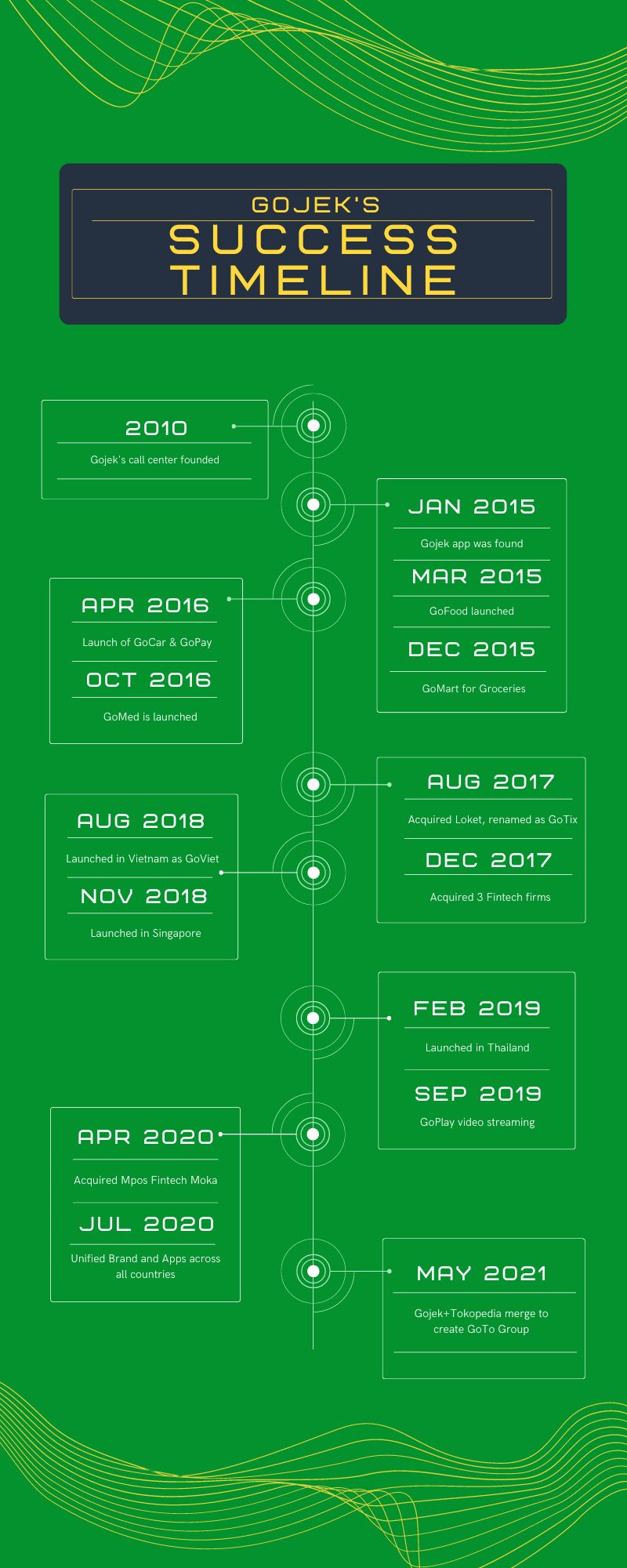
Now, coming to the revenue model of Gojek. The stakeholders get a commission from various user segments.
The Gojek app users need not install diverse apps to fulfill their needs. By only using Gojek, they can get access to 20+ services.
However, for this conveniently fast service, the users need to pay a service fee of 10% on the entire order.
Merchants usually want to showcase their products and services on Gojek. That’s because the app offers multiple avenues for users to earn revenue. This is why the app has a huge customer base and popularity.
Gojek charges a small commission from the retailers on every order that they get. This commission is automatically deducted from the retailer’s wallet when they hand over the product to the delivery guy.
Drivers and delivery partners also need to pay Gojek a commission of 20% for every order they deliver. It encourages them to deliver more products to gain profit.
Like the Gojek app, a Gojek clone is loaded with robust features that offer the user maximum utility and convenience. Specific features are available to individual users and organizations.
It has a dashboard where all the crucial business data is automatically configured. It is particularly useful to a multi-service business that has different components to track.
The stakeholder gets the real-time status of company operations to assess, manage, and optimize them on time.
Business owners can locate their business in many countries and cities. Accordingly, they can gather insights about the industry through the power of analytics.
It is a feature within the solution that automates all the revenue and profit tracking channels.
Users need the convenience of secure payment gateways, especially when they are located in various countries.
Using the admin panel, the admin can control & manage the business process.
| Dashboard | Manage vendors | Manage categories | General settings | Manage deliveries | Manage customers | Manage multi-services | Manage products |
| Manage orders | Manage delivery areas | Manage multi-currency | Push notifications | Loyalty programs | CMS activity & logs | Feedbacks and reviews | Reports |
| Control management | Manage multi-currency | Payment gateways | Social media profile management | Order details | Track orders |
Then, there are some crucial features a Gojek clone must-have for the users.
There is a hassle-free sign-up process for users if they log in with their social apps as their data is already stored in their social media accounts.
This feature simplifies customer details registration as the data is already there in the social apps.
Customers are allowed to give reviews or add feedback on their received orders. This enhances brand trust and also allows the business to improve its methods.
As mentioned earlier, this feature allows customers to choose from multiple payment methods such as cash on delivery, net banking, credit/debit cards, and online wallets. The customer can choose as per their convenience.
Enable customers to track their order status or service provider’s status in real-time.
When businesses operate in different countries, consumers can choose their language preferences.
The makers of Gojek have recently added some new features.
Commuters must take a list of key precautions when using Gojek’s ride-hailing service–like wearing a mask at all times.
All customers are shown the ‘pledge’ icon when they book a ride. They can complete their booking and future orders only by tapping on the ‘I Accept button & accepting the Pledge.
The Gojek team found that customers are more likely to share feedback if they get the option to do it while on the ride. Such feedbacks are authentic and valuable at the same time.
So, now, commuters using the Gojek app can easily report feedback while they are on a trip. Earlier, they could do this only after the ride ends.
All they have to do is tap on any of the brightly-colored feedback cards at the bottom of the booking screen.
This is a handy button on the Gojek app that reassures commuters of their safety and security while on a ride. When tapped on, the button reveals a drop-down menu of several safety functions, including an option for users to share their trip with loved ones.
Further, there’s a handbook with detailed information on how Gojek rides are kept safe and tidy.
Users can log into their Gojek accounts using device-based authentication–facial recognition or fingerprint identification–or Magic Link (an authentication URL for verifying a user’s device).
Both login methods significantly reduce the risk of account takeovers and better protect the user’s account.
Gojek equips its driver-partners with masks, wet wipes, and hand sanitizers to create a safe ride environment.
And to safeguard commuters, they actively encourage the use of cashless methods like debit or credit cards to pay for trips.
Gojek also provides the facility of number masking that ensures that users’ phone numbers are kept private at all times.
| Signup | Profile set up | Language and general setting | Select a service | Filter by location and other advanced filters | Order details | Order history | Live order tracking |
| Payment & checkout | Payment methods | Review and Ratings | In-app chat | In-app call | Schedule services | Social media logins | Ridesharing |
| Fare assessment | Calculated travel time | ||||||
| Login/Signup | Profile set up | Dashboard | Order details | Accept/Reject order | Manage orders | Manage listings | Manage vouchers |
| Push notifications | Check ratings | Manage delivery timing | Order service history | Profit details | In-app chat | In-app message |
| Login/Signup | Delivery status | Order status | Accept/Reject orders | GPS navigation | In-app call | Reports | Reviews/Feedbacks |
| Incoming orders | Push notifications | ||||||
The cost to build a Gojek clone depends on many factors. These can be anything, right from the tech stack to platform complexity to the wide-ranging features of the app.
Here are some of the major factors that affect the cost of Gojek clone app development.
First & foremost, it is imperative to finalize the platform where the application will be deployed & used by clients.
There are mainly two Gojek clone app development platforms:
First things first, it is possible to develop a super app that is compatible with both platforms. But, there is also a third option– a cross-platform mobile app. As iOS is backed by Apple, it is the least expensive in terms of development. Then, comes the android application, and lastly, the cross-platform is a bit exorbitant.
The more complex a mobile app, the more time it will take to develop. Hence, more time means more costs.
Building a Gojek clone is complex as over 20 service functions need to be incorporated into the mobile app. Further, for every function, there needs to be a user and an admin panel.
A basic mobile app has only basic features and doesn’t cost much. But, if a more complex app is created, it will cost more as it will have more advanced features.
It is one of the main aspects of a mobile app. Here, you need to arrive at a balance. Though less is more when it comes to design, sometimes it’s good to jazz things up a bit to give the customer a better user experience.
But then again, design complexity is directly proportional to the cost. So, it is up to you to decide what design would be best considering the budget you have or can afford to exceed.
A USA-based mobile app development company will charge more to develop a Gojek clone than a company located in Asia.
The reason: the average wage and the average development cost are higher in a country like the USA as compared to their Indian counterparts.
Here is a table mentioning the approximate per-hour rate to build a Gojek clone for Android and iOS platforms in various countries.

While developing a white-label on-demand multi-service Gojek clone app for your business will cost you around $6,000. Whereas, a 100% customized solution would cost somewhere between $15,000-$40,000.
This is the final stage before you make the Gojek clone go LIVE on Play Store and App Store.
You can choose any one of the three options to develop a mobile app.
These are built for a single platform like Android, Windows, or iOS. Such apps have their programming languages and development tools.
Here, only a single app is built on HTML5 and is then optimized for various platforms. Just like native apps, hybrid apps are also installed from the app store.
Here, a website is created and fully optimized for mobile. These mobile apps look almost the same as native/hybrid apps but work on browsers just like any other website.
Their UI/UX is not as high-end as that of native/hybrid apps.
Though there are immense possibilities about the number or type of features you can incorporate, however, stated below are the absolute must-have features in a Gojek app clone.
It enables the users to sign up & log into the app easily and quickly.
This feature enables users to track service providers & get to know their LIVE location.
The Gojek clone must support multiple languages so that users can choose the language of their choice. Besides, this feature will help you cover a large target audience.
Using this feature, you can send updates to users regarding orders dispatched, orders about to arrive, orders received, and much more.
A payment gateway acts as a link between your website and a payment provider/card network. It authorizes and processes online payments.
Integrating the payment gateway will make the last leg–making the transaction–of the purchase convenient for all parties involved.
Allow the users to schedule their bookings well in advance so that they can commute regularly.
Booking in advance works in the favor of users also because due to unexpected excessive demand or weather conditions, the drivers may not be available right at that time when the cab is booked.
To support multiple functionalities within one app, the technology used to build such apps must be robust enough to seamlessly handle these functions.
Once you have decided on your Gojek clone mobile app’s goals, target audience, business model, and defined budget and features, it’s time to start building the architecture.
Get the wireframes made as these will help you in a better conceptual understanding of your app.
Using wireframes, you have the skeleton of your mobile app. Wireframes are created before starting with the actual backend code.
It helps to visualize what your future super app would look like. This includes text fields, pop-ups, buttons, and much more.
Once you’ve finalized the wireframe, it’s time to tell the developers to start with the front-end development and back-end coding.
Make sure that you choose a premium super app development company to successfully execute your vision and create a quality app that stands out.
Before making your super app go LIVE, make sure your app is bug-free and good to use.
Though your development team will do the alpha testing, you should always test the app with real users too. For that, beta testing is conducted.
Through beta testing, you will get users’ feedback related to app performance and their experience with your app.
After fixing all the bugs and issues reported by users, it is now time for you to finally release your super app in the market!

In other words, what’s in store for the future of your Gojek clone app?
As the digital and physical spaces are increasingly intersecting, super apps have come as a respite; they offer several day-to-day solutions (and conveniences) in our personal and professional lives.
Already, established super apps–like Gojek-have carved a niche for themselves in the Asian market. But a major portion of the global market remains wanting new contenders, especially in the North American and European markets.
And, that could be you!
The coding ninjas at Code Brew Labs have been brewing robust super apps for over 10 years now. We have catered to the app development needs of small, medium, and large businesses for a while now.
During this time, we have catered to a wide range of industries–right from food to grocery delivery app to ridesharing. We promise to deliver a seamless user experience through all the solutions we offer. And we’re always looking to hear your innovative ideas and make them a reality through our app solutions.
Have an idea? Talk to us. We’ll be more than happy to assist you.
While there are endless possibilities in the digital product development industry, changes will also keep happening. As such, product owners and community managers will have to approach engagement in an entirely different way. So, this will be a challenge.
But constantly evolving social features will keep bringing multiple functionalities together. This will reduce friction for users and helps to earn their long-term loyalty.
So, there isn’t a better time than now to launch a Gojek clone. Contact us now!
